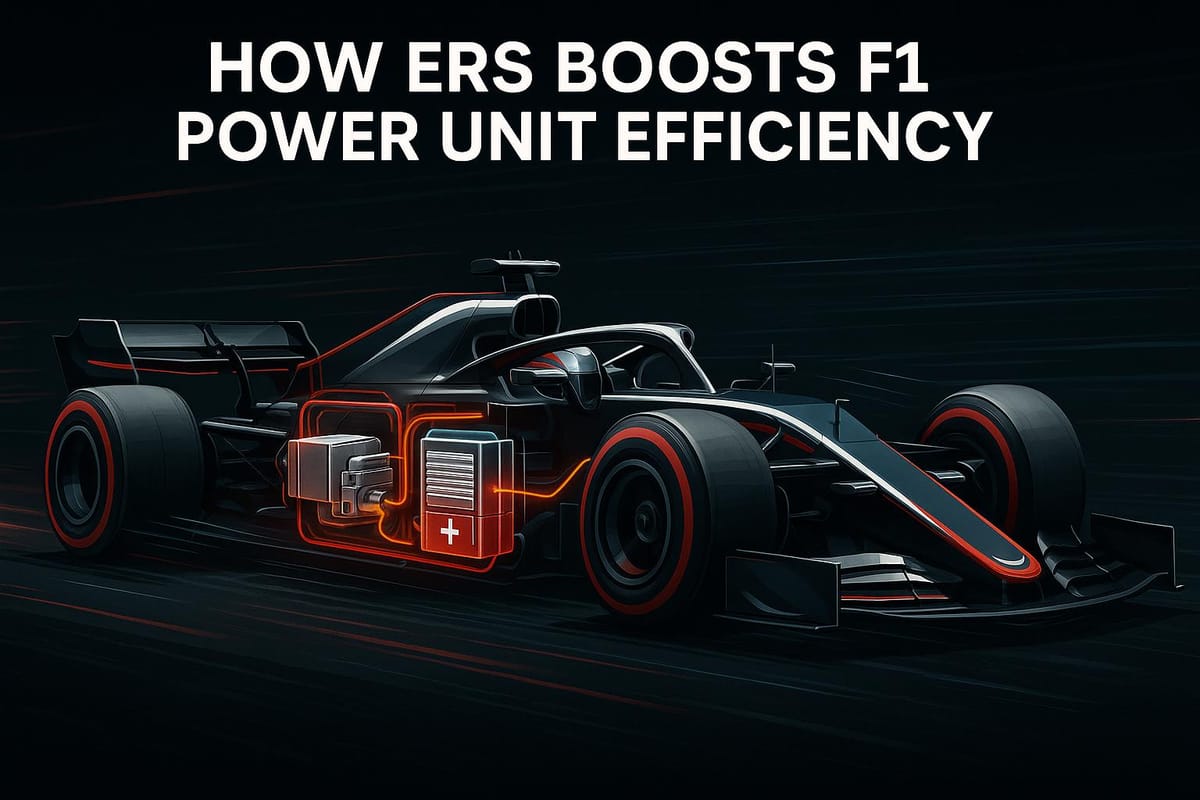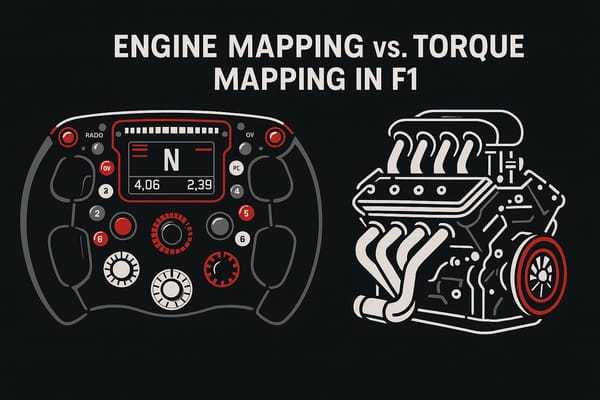How ERS Boosts F1 Power Unit Efficiency
Explore how the Energy Recovery System in F1 enhances power unit efficiency, boosts performance, and promotes sustainability.

Formula 1's Energy Recovery System (ERS) transforms wasted energy into usable power, adding 160 horsepower to a car’s output while improving fuel efficiency by about 35%. The system combines two technologies:
- MGU-K: Recovers up to 2 MJ of braking energy per lap and deploys up to 4 MJ for acceleration.
- MGU-H: Converts unlimited exhaust heat into electrical energy, reducing turbo lag and boosting performance.
Stored energy is managed by a lithium-ion battery and deployed strategically for overtaking, defending, or maximizing lap speeds. FIA regulations limit energy recovery and deployment, pushing teams to optimize usage for competitive advantage. With upcoming 2026 changes, electrical output will increase to 350 kW, further advancing F1's hybrid technology.
F1 Uncovered: How Do We Keep the ERS Cool?
What is the Energy Recovery System (ERS)?
The Energy Recovery System (ERS) is a hybrid technology designed to capture and repurpose energy that would otherwise be wasted during a race. By working alongside the internal combustion engine (ICE), it boosts power unit performance and efficiency.
Main Components of the ERS
The ERS consists of three key components, each playing a unique role in energy conversion and storage:
-
Motor Generator Unit – Kinetic (MGU-K)
The MGU-K captures energy generated during braking and converts it into electrical power. It can supply up to 120 kW (equivalent to 160 horsepower) of extra power directly to the drivetrain. -
Motor Generator Unit – Heat (MGU-H)
The MGU-H harnesses thermal energy from the turbocharger's hot exhaust gases. In addition to generating power, it helps control the turbocharger's speed, minimizing turbo lag. -
Energy Store (ES)
This lithium-ion battery, weighing about 44 pounds (20 kilograms), stores the electrical energy collected by the MGU units. It is housed within the fuel cell for optimal integration.
How the ERS Works with the Engine
The ERS and the internal combustion engine work together to create a smooth and efficient power delivery system. A specialized control unit manages the flow of energy between the components, ensuring compliance with FIA regulations while maximizing performance.
Here are some key details about the system's functionality:
- The MGU-K can recover up to 2 megajoules (MJ) of energy per lap through braking.
- Up to 4 MJ of energy can be deployed to the drivetrain per lap.
- The MGU-H operates without limits on energy recovery or transfer to other components.
This collaboration between the ERS and the ICE gives teams a powerful tool to enhance performance within the constraints set by FIA rules, making it an essential part of modern Formula 1 technology.
How F1 Cars Collect Energy
F1 cars are marvels of engineering, designed to reclaim and repurpose energy that would otherwise go to waste. This energy recovery happens through advanced systems working together seamlessly during a race.
Braking Energy Recovery with MGU-K
The Motor Generator Unit - Kinetic (MGU-K) is a key component that turns braking force into usable electrical energy using regenerative braking. It’s directly connected to the crankshaft, enabling it to deliver an extra 160 horsepower for up to 33 seconds per lap.
Here’s how it works:
- It links to the drivetrain to convert mechanical energy into electrical power.
- Activates during deceleration, capturing energy that would otherwise dissipate as heat.
- Feeds the recovered energy into the car’s energy storage system for later use.
Heat Energy Recovery with MGU-H
While the MGU-K focuses on kinetic energy, the MGU-H targets thermal energy from the turbocharger system. Operating in an environment where exhaust gas temperatures exceed 1,000°C, this unit spins at over 120,000 RPM to convert heat into electrical energy.
"The MGU-H uses exhaust gas entropy (the heat energy remaining in the exhaust gas as a function of its temperature, expansion, and mass flow rate) to spin the turbine during the energy recovery phase, converting the energy from the exhaust gases into electrical energy." - Racecar Engineering
The MGU-H has multiple critical roles:
- Captures exhaust heat and transforms it into electrical energy.
- Reduces turbo lag by actively controlling the turbocharger’s speed.
- Transfers power directly to the MGU-K when additional energy is needed.
Energy Storage Management
Recovering energy is only half the equation - storing and deploying it effectively is just as important. F1 cars use high-capacity battery systems operating at 400 volts, with a storage capacity of 4-6 kWh.
| Energy Flow Direction | Maximum Limits | Usage Strategy |
|---|---|---|
| MGU-K Recovery | 2 MJ per lap | Optimized during braking zones |
| MGU-K Deployment | 4 MJ per lap | Used during acceleration phases |
| MGU-H Recovery | Unlimited | Continuously active |
| Battery Storage | 4-6 kWh | Managed dynamically |
These energy limits play a pivotal role in race strategy. Teams and drivers monitor battery levels closely, ensuring they stay above 50% while strategically deploying power during overtakes or defensive maneuvers.
"Batteries are integral to modern Formula 1 racing. They not only provide crucial power boosts but also represent a significant area of innovation within the sport. Ensuring their reliability and efficiency is paramount for competitive success." - Redway Tech Expert
Energy Usage During Races
Once teams have mastered how to collect energy, their next challenge is figuring out the best way to deploy ERS (Energy Recovery System) during the most critical moments of a race. This can make or break their strategy.
Power Boost for Passing
ERS plays a pivotal role in overtaking. The system provides an extra 160 horsepower, giving drivers a crucial edge during passing maneuvers. To activate this, drivers use an overtake function, which releases stored energy instantly. The best moments to deploy this burst of power include:
- Exiting corners onto straights, where acceleration is key
- Approaching overtaking zones, to gain speed before making a move
- Defending against trailing cars, to maintain position
While this power boost is a game-changer, it’s just one piece of a much larger race strategy puzzle.
Race-Long Energy Management
Drivers can adjust engine modes to control ERS usage, balancing between power output and fuel efficiency. The strategy for deploying energy often depends on the track type, as shown below:
| Track Type | Energy Strategy | Key Focus |
|---|---|---|
| High-Speed | Conservative deployment | Save energy for crucial overtaking moments |
| Technical | Frequent recharging | Maximize energy recovery in braking zones |
| Mixed | Balanced approach | Optimize energy for specific track sections |
Qualifying vs. Race Energy Use
Energy deployment strategies shift dramatically between qualifying laps and race conditions. During qualifying, the goal is to unleash maximum power for a single, fast lap. In contrast, races demand a more calculated approach to sustain energy over the entire distance. Here's how the strategies differ:
| Aspect | Qualifying | Race |
|---|---|---|
| Power Output | Full power | Strategic conservation |
| Fuel Load | Minimal | Full race distance |
| ERS Strategy | Maximum deployment | Carefully optimized |
| DRS Usage | Unrestricted in zones | Dependent on track position |
As the race nears its conclusion, energy management becomes even more crucial. Smart deployment during these final laps can often decide the outcome, making it a critical part of any team's strategy.
Rules and Technical Progress
Formula 1's rules play a pivotal role in how teams design and refine their Energy Recovery Systems (ERS), balancing cutting-edge performance with sustainability goals.
Battery Capacity Rules
The FIA enforces strict regulations on ERS battery capacity to ensure fair competition while encouraging technological advancements. Current guidelines define specific energy limits for various components:
| Component | Energy Limit | Usage Restriction |
|---|---|---|
| MGU-K | 2 MJ recovery/lap | 4 MJ deployment/lap |
| MGU-H | Unlimited recovery | Deployment capped to MGU-K |
| Regulatory Power Output | 120 kW | Approximately 161 horsepower |
These restrictions challenge teams to develop energy storage systems with precise capacity and discharge capabilities. Additionally, stringent fuel consumption rules further influence how ERS is integrated into the overall design.
Fuel Limits and ERS
Fuel regulations are another key factor shaping ERS deployment. Current fuel rules directly impact the way teams approach energy recovery and usage:
| Parameter | Current Limit | Impact on ERS |
|---|---|---|
| Race Fuel Load | 110 kg | Promotes efficient energy recovery |
| Fuel Flow Rate | 100 kg/h | Encourages reliance on electric power |
| Power Split | 80:20 (ICE:ERS) | Drives hybrid system optimization |
Looking ahead, major changes are set to redefine F1's hybrid systems starting in 2026:
- Electrical power output will jump from 120 kW to 350 kW.
- Braking energy recovery will double, reaching 8.5 megajoules per lap.
- An MGU-K Override will be introduced to improve overtaking capabilities.
These updates aim to achieve a 50:50 power split between the internal combustion engine (ICE) and electrical systems, signaling a bold step toward greater electrification in Formula 1.
Conclusion
ERS has revolutionized Formula 1 power units, boosting performance while significantly cutting fuel consumption - by about 35% - and recovering up to 160 horsepower in the process. These advancements have not only enhanced race-day strategies but also made the sport more efficient.
A memorable example of energy recovery's impact dates back to 2009, when Kimi Räikkönen's clever use of KERS at the Belgian Grand Prix highlighted how these systems could change the game. What began as a breakthrough has evolved into the highly integrated ERS systems we see today.
Looking ahead, ERS technology is set to advance further. The 2026 regulations aim for a 50% reduction in carbon emissions compared to the pre-2014 era. Current cars use about 100 kg of fuel per race, a significant drop from the nearly 200 kg needed during the V8 engine days. These strides illustrate how ERS innovations continue to push the boundaries of both performance and sustainability.
"We believe Formula 1 can set an example of how a sustainable fuel can be created and used" - Ross Brawn, Managing Director of Motor Sports at Formula 1
FAQs
How does the MGU-H help reduce turbo lag in F1 cars?
The MGU-H (Motor Generator Unit-Heat) is a key component in managing turbo lag in F1 cars. By directly controlling the turbocharger's speed, it ensures the turbo remains active even when exhaust gas flow isn't strong enough. This results in quicker responses and a smoother power delivery.
Beyond that, the MGU-H converts heat energy from the exhaust into electrical energy. This electricity can either be stored in the car's battery or used to keep the turbo spinning, eliminating acceleration delays and boosting engine performance.
What changes are coming to the F1 Energy Recovery System (ERS) in 2026, and how will they affect racing?
Formula 1's ERS Overhaul in 2026

Starting in 2026, Formula 1 is set to roll out significant upgrades to its Energy Recovery System (ERS), aiming to enhance both performance and efficiency. The headline change? The ERS power output will triple to 350 kW - roughly 469 horsepower - which will contribute to about 50% of the car's total power. This shift is designed to improve energy efficiency and reduce reliance on traditional fuels, aligning with Formula 1's push toward sustainability.
Another exciting update is the introduction of a Manual Override mode. This feature will let drivers tap into extra ERS power during critical moments, whether they're making an aggressive overtaking move or defending their position. These changes promise to add a new layer of strategy and excitement to races, as teams will need to master the art of managing this increased electrical power throughout the competition.
How does the Energy Recovery System (ERS) enhance the efficiency of F1 power units during a race?
The Energy Recovery System (ERS) is a game-changer in Formula One, designed to capture and reuse energy that would otherwise be lost. It pulls energy from two primary sources: the heat produced by the turbocharger and the kinetic energy generated during braking. Once collected, this energy is stored in a battery and used strategically to deliver a power boost at key moments - think overtaking an opponent or defending a position on the track.
By fine-tuning how energy is captured and deployed, the ERS helps teams push their performance to the limit while staying within strict fuel and power regulations. This cutting-edge system not only boosts speed and efficiency but also highlights Formula One's drive for innovation and its efforts to promote sustainability in the world of motorsport.




